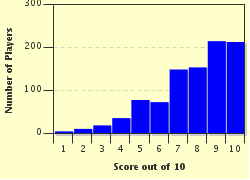Quiz Answer Key and Fun Facts
1. In 1929, the movie "Gold Diggers of Broadway" was released and a song featured in it made waves on the music charts of the day as well - ten weeks at Number One! About forty years later the song reappeared on the Hot 100 peaking at Number 17. I'll give you one line of the song for a bonus clue; "And if I kiss you in the garden, in the moonlight, will you pardon me". Name the song.
2. In 1930, a Number One song featured the following lines:
"That's where each and every Lulu Belle goes
Every Thursday evening with her swell beaux
Rubbing elbows"
In 1983, the song resurfaced on the Billboard charts peaking at Number Four.
The lines quoted above were changed thusly to reflect the changing times.
"Dressed up like a million dollar trooper
Trying hard to look like Gary Cooper
Super-duper!"
What song was it?
3. Our next number is a true "Daily Triple", Alex. In 1928, it was released by several artists but Paul Whiteman reached the top of the charts with it. In 1944, it charted with three different performers, its highest position Number Three with Helen Forrest and Dick Haymes. Finally, in 1961 it reached Number Six on the Hot 100 and I'd like you to identify the recording artist that put it there. Here's a rather generous chunk of the lyric to help you along.
"We strolled the lane together
Laughed at the rain together
Sang love's refrain together
And we'd both pretend it would never end
But one day we cried together
Cast love aside together
You're gone from me but in my memory
We always will be together"
4. A Number One hit in 1944 received a bit of a reprieve in 1967. Not a big one, mind you, as its chart position on the Hot 100 would suggest... Number 75. However, I'm banking that enough people have either heard the original or the cover to come up with the title. Here's your lyrical clue (one line) and if the words sound queer and funny to your ear, a little bit jumbled and jivey, that's okay... they should! Identify this song.
"A kiddley divey too, wouldn't you"
5. "Stars shining bright above you
Night breezes seem to whisper I love you
Birds singing in the sycamore tree"
These lines come from a song that topped the charts in 1931 and peaked at Number 12 in 1968. What was its title?
6. Certainly Cole Porter must be considered one of the foremost composers of American pop music of the 20th century yet it was extremely difficult to find a suitable example of one of his songs that would meet our quiz criteria. But, I found one and here's a line of the lyric as a clue.
"In olden days a glimpse of stocking was looked on as something shocking"
A Number five hit in 1934 for Paul Whiteman and a "soft" Number 43 hit in 1967 for Harper's Bizarre, what was it?
7. One name keeps appearing over and over among the recording artists that I've been citing from the 1920s and 1930s... Paul Whiteman. In January 1934, he had a Number One hit for six weeks. Exactly 25 years later to the month, January 1959, a cover version of that hit reached Number One again for three weeks. Here's the lyrical clue, you name the song.
"They asked me how I knew my true love was true
I of course replied something here inside cannot be denied"
8. In 1923, five different recording artists hit the charts with a little ditty, a sample of which follows:
"Right to the end just like a friend
I tried to warn you somehow
You had your way, now you must pay"
Thirty-five years later it was a Number Four hit and launched a successful recording career. Can you name it?
9. "Fools rush in where angels fear to tread
And so I come to you, my love, my heart above my head
Though I see the danger there
If there's a chance for me then I don't care
Fools rush in where wise men never go
But wise men never fall in love so how are they to know
When we met I felt my life begin
So open up your heart and let this fool rush in"
That's the entire lyric for a Johnny Mercer-Rube Bloom composition that spent a week at Number One for Glenn Miller in 1940. As usual, at the time, Ray Eberle handled the vocals. What recording act covered it in 1963 and scored a modest Number 12 hit on the Hot 100?
10. In 1930, George and Ira Gershwin wrote the music and lyrics for a Broadway production starring Ginger Rogers, "Girl Crazy". One of their compositions was the pop standard "Embraceable You". Another has become a jazz classic most commonly associated with Ethel Merman but a contemporary chart success for Red Nichols at Number Five and Ethel Waters at Number 17. It was covered in 1967 by The Happenings and they scored a big Number Three hit with their version. What song featured these lines?
"Old man trouble, I don't mind him
You won't find him 'round my door"
Source: Author
maddogrick16
This quiz was reviewed by FunTrivia editor
agony before going online.
Any errors found in FunTrivia content are routinely corrected through our feedback system.

